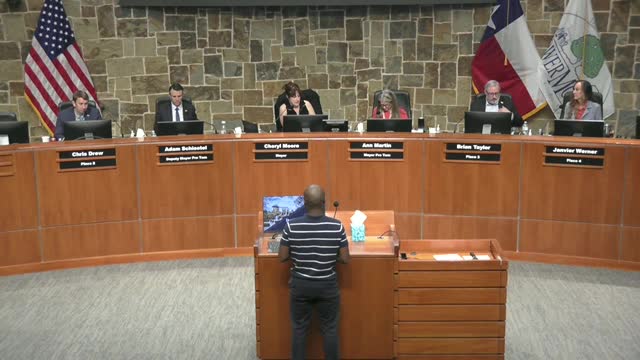Council expands dangerous‑dog code to cover serious bodily injury to animals, aligning procedures with human‑injury provisions
October 06, 2025 | Flower Mound, Denton County, Texas
This article was created by AI summarizing key points discussed. AI makes mistakes, so for full details and context, please refer to the video of the full meeting. Please report any errors so we can fix them. Report an error »

The Flower Mound Town Council amended the town code to expand the definition and procedures for dangerous animals to include cases where an animal causes “serious bodily injury” to another animal, bringing animal‑to‑animal incidents under the same seizure, hearing and disposition framework now used for human injuries.
Blake (animal services/staff presenter) told the council the change was requested after a recent incident in town and noted that the town’s dangerous‑dog provisions already largely mirror Texas Health and Safety Code, Chapter 822. The amendment adds a definition of “serious bodily injury to an animal” to include “severe bite wounds, fractures, or severe ripping and tearing of muscles or tissues that would cause a reasonably prudent animal owner to seek treatment from a medical professional or licensed veterinarian and that would require immediate emergency veterinary care to preserve life or prevent further suffering.” The text specifies that the definition applies “without regard to whether such care was actually obtained.”
Under the amended division, when a report is filed the animal may be seized with a warrant, held at animal services, and a hearing scheduled within 10 days; if the court finds the animal caused serious bodily injury, the disposition can include euthanasia as provided for by the state code. Staff said the statute allows the town to assess costs to the owner and that existing cost‑recovery processes will apply.
Councilmembers stressed the ordinance was a response to a “horrific” incident and that the amendment balances livestock and pet‑owner concerns with animal‑welfare and public safety; the measure passed unanimously.
Blake (animal services/staff presenter) told the council the change was requested after a recent incident in town and noted that the town’s dangerous‑dog provisions already largely mirror Texas Health and Safety Code, Chapter 822. The amendment adds a definition of “serious bodily injury to an animal” to include “severe bite wounds, fractures, or severe ripping and tearing of muscles or tissues that would cause a reasonably prudent animal owner to seek treatment from a medical professional or licensed veterinarian and that would require immediate emergency veterinary care to preserve life or prevent further suffering.” The text specifies that the definition applies “without regard to whether such care was actually obtained.”
Under the amended division, when a report is filed the animal may be seized with a warrant, held at animal services, and a hearing scheduled within 10 days; if the court finds the animal caused serious bodily injury, the disposition can include euthanasia as provided for by the state code. Staff said the statute allows the town to assess costs to the owner and that existing cost‑recovery processes will apply.
Councilmembers stressed the ordinance was a response to a “horrific” incident and that the amendment balances livestock and pet‑owner concerns with animal‑welfare and public safety; the measure passed unanimously.
View full meeting
This article is based on a recent meeting—watch the full video and explore the complete transcript for deeper insights into the discussion.
View full meeting
